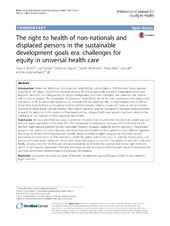| dc.contributor.author | Brolan, Claire E | en_US |
| dc.contributor.author | Forman, Lisa | en_US |
| dc.contributor.author | Dagron, Stéphanie | en_US |
| dc.contributor.author | Hammonds, Rachel | en_US |
| dc.contributor.author | Waris, Attiya | en_US |
| dc.contributor.author | Latif, Lyla | en_US |
| dc.contributor.author | Ruano, Ana Lorena | en_US |
| dc.date.accessioned | 2020-04-28T08:28:14Z | |
| dc.date.available | 2020-04-28T08:28:14Z | |
| dc.date.issued | 2017-02-21 | |
| dc.Published | Brolan, Forman, Dagron, Hammonds, Waris, Latif, Ruano. The right to health of non-nationals and displaced persons in the sustainable development goals era: challenges for equity in universal health care. International Journal for Equity in Health. 2017;16:14 | eng |
| dc.identifier.issn | 1475-9276 | |
| dc.identifier.uri | https://hdl.handle.net/1956/22032 | |
| dc.description.abstract | Introduction: Under the Millennium Development Goals (MDGs), United Nations (UN) Member States reported progress on the targets toward their general citizenry. This focus repeatedly excluded marginalized ethnic and linguistic minorities, including people of refugee backgrounds and other vulnerable non-nationals that resided within a States’ borders. The Sustainable Development Goals (SDGs) aim to be truly transformative by being made operational in all countries, and applied to all, nationals and non-nationals alike. Global migration and its diffuse impact has intensified due to escalating conflicts and the growing violence in war-torn Syria, as well as in many countries in Africa and in Central America. This massive migration and the thousands of refugees crossing borders in search for safety led to the creation of two-tiered, ad hoc, refugee health care systems that have added to the sidelining of non-nationals in MDG-reporting frameworks. Conclusion: We have identified four ways to promote the protection of vulnerable non-nationals’ health and well being in States’ application of the post-2015 SDG framework: In setting their own post-2015 indicators the UN Member States should explicitly identify vulnerable migrants, refugees, displaced persons and other marginalized groups in the content of such indicators. Our second recommendation is that statisticians from different agencies, including the World Health Organization’s Gender, Equity and Human Rights programme should be actively involved in the formulation of SDG indicators at both the global and country level. In addition, communities, civil society and health justice advocates should also vigorously engage in country’s formulation of post-2015 indicators. Finally, we advocate that the inclusion of non-nationals be anchored in the international human right to health, which in turn requires appropriate financing allocations as well as robust monitoring and evaluation processes that can hold technocratic decision-makers accountable for progress. | en_US |
| dc.language.iso | eng | eng |
| dc.publisher | BioMed Central (BMC) | eng |
| dc.rights | Attribution CC BY | eng |
| dc.rights.uri | http://creativecommons.org/licenses/by/4.0/ | eng |
| dc.subject | Sustainable development goals | eng |
| dc.subject | Millennium development goals | eng |
| dc.subject | Refugees | eng |
| dc.subject | Health of non-nationals | eng |
| dc.subject | Right to health | eng |
| dc.title | The right to health of non-nationals and displaced persons in the sustainable development goals era: challenges for equity in universal health care | en_US |
| dc.type | Peer reviewed | |
| dc.type | Journal article | |
| dc.date.updated | 2020-01-19T11:18:30Z | |
| dc.description.version | publishedVersion | en_US |
| dc.rights.holder | Copyright 2017 The Author(s) | |
| dc.identifier.doi | https://doi.org/10.1186/s12939-016-0500-z | |
| dc.identifier.cristin | 1776702 | |
| dc.source.journal | International Journal for Equity in Health | |

